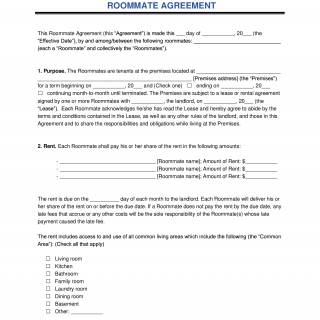Roommate Agreement / Contract
What is a Roommate Agreement? A roommate agreement serves as a legally binding document that roommates can utilize to enforce financial responsibilities, such as rent payment if one roommate falls short. However, enforcing non-financial aspects of the agreement, such as chore distribution, might be less feasible.
When approaching a roommate situation, it's advisable to take the extra step of ensuring clarity. Remember that house rules can be tailored to be either stringent or flexible, according to your preferences.
What to Include in a Roommate Agreement:
Your roommate agreement should encompass the following points:
-
Expense Breakdown: Outline each tenant's contribution towards shared costs, including rent, security deposit, utilities, and communal supplies or groceries.
-
Shared and Private Spaces: Clearly define common areas and rooms designated as private for one or more tenants.
-
Guests and Gatherings: Agree upon protocols for inviting guests, with unanimous consent required for certain situations. Set parameters for visitor frequency and establish guidelines for parties or larger gatherings.
-
Pets: Consider your stance on pets if allowed by the lease, even if none of your current roommates plan to have one. Detail arrangements for pet care and potential property damage.
-
Chores: Lay out expectations for regular upkeep and deep cleaning of shared spaces like bathrooms, kitchens, and living areas. Consider creating a rotational schedule for daily, weekly, and monthly chores.
-
Quiet Hours: Encourage communication of each tenant's schedule to respect rest and study routines. Define quiet hours during which noise should be minimized.
-
Early Departure: Address concerns about roommates leaving before the lease term ends. Discuss scenarios where individuals might move out early and their responsibility for rent payment. Include options like subletting or lease transfers, if permitted.
-
Sharing and Borrowing: Prevent disagreements by clarifying when borrowing each other's belongings is acceptable. Extend these rules to communal items like cooking supplies.
-
Additional House Rules: Acknowledge that not all scenarios can be foreseen, but consider including rules for potential points of contention like house temperature, shared parking, or shower times. Agree to add any extra stipulations in writing after mutual consent.
It's prudent to recognize that disagreements might arise beyond the scope of the initial agreement. Stay open to amending house rules as needed to maintain harmonious roommate relationships.
Why is a Roommate Agreement Necessary? A roommate agreement is crucial to prevent conflicts among cohabitants, whether they are unfamiliar renters or close friends. Many universities mandate students in campus housing to complete dorm roommate agreements. Crafting a comprehensive set of roommate rules at the outset significantly minimizes disputes and fosters positive roommate dynamics.
Creating a Roommate Agreement - Simplified Steps
- Step 1: Get a Template Find a free roommate agreement template online. You can either fill it out directly on a website or download it as a PDF/DOC.
- Step 2: Talk to Roommates Sit down with your roommates and use the template as a guide to discuss the rules you want to have in your living situation.
- Step 3: Fill in and Sign Once everyone agrees on the rules, fill in the template with the information. Then, everyone should sign and date it.
Remember, you can always update the agreement if needed.
Writing a Roommate Agreement - Simplified Guide
- Step 1: Start Date and Names Put the date the agreement begins and list the names of all roommates.
- Step 2: Key Information Write the address of the place you're sharing, how long the agreement lasts, and the landlord's name.
- Step 3: Rent Details Specify who pays what for rent, when it's due, and which areas everyone can use.
- Step 4: Security Deposit Say how much each person pays for the security deposit.
- Step 5: Utilities Decide which utilities you share, like water and electricity.
- Step 6: Cleaning and Maintenance Agree on who does what for cleaning and set a schedule.
- Step 7: Pets, Smoking, Alcohol, and Firearms Discuss whether pets, smoking, alcohol, and firearms are allowed.
- Step 8: Borrowing and Quiet Hours Decide on borrowing stuff and if you'll have quiet hours for less noise.
- Step 9: Guests and Parties Talk about having guests over and throwing parties.
- Step 10: Solve Issues Decide if you'll use mediation to solve problems.
- Step 11: Laws Say which state's laws apply to the agreement.
- Step 12: Extra Rules Add any other rules you think are important.
By following these steps, you'll have a simple and clear roommate agreement in place to avoid misunderstandings and conflicts.
In conclusion, a well-crafted roommate agreement offers a host of benefits that contribute to a harmonious and stress-free shared living experience. By outlining clear rules, responsibilities, and expectations, this agreement prevents conflicts, encourages open communication, and promotes a respectful environment. It ensures financial transparency, defines chore distribution, and establishes guidelines for guests, pets, and more. Additionally, the agreement provides a framework for resolving disputes and serves as a point of reference. Ultimately, a roommate agreement fosters positive relationships, minimizes misunderstandings, and enhances the overall quality of communal living.

